Following the public release of ChatGPT in November 2022, it was expected that other prominent tech companies would follow suit with their own versions of AI chatbots. In line with these expectations, Bard AI, Google’s response to OpenAI’s groundbreaking chatbot, debuted in March 2023.
ChatGPT harnesses the computational power of OpenAI’s advanced language model, GPT-3.5. Subscribers to the paid version of ChatGPT will have the opportunity to leverage the enhanced capabilities of GPT-4, which excels in tackling intricate queries and addressing complex problems. In contrast, Bard initially relied on Google’s LaMDA model for generating dialogues but has since transitioned to the more potent PaLM 2 model. This divergence in underlying models means that the rival chatbots, Bard and ChatGPT, may approach and respond to questions in distinct ways, further adding to the intrigue of the Google Bard vs ChatGPT comparison.
In this post, we will highlight 10 reasons why Google Bard surpasses ChatGPT in diverse aspects. From enhanced dialogue generation to improved contextual understanding and distinct features, Google Bard AI presents a captivating case for its superiority.
Also Read- Microsoft Bing Vs Google Bard- Which Is Leading The Race
What is Google Bard AI?
Google Bard stands at the forefront of AI chatbot technology, developed by none other than Google itself. This cutting-edge tool is specifically crafted to replicate human-like conversations, harnessing the power of natural language processing and machine learning. With its advanced capabilities, Google Bard sets a new standard for chatbot experiences, offering users a remarkably realistic and engaging interaction. It leverages progressive techniques to deliver a highly realistic conversational experience. Its functionality extends beyond enriching the Google search experience, as it can seamlessly incorporate into websites as well as messaging platforms and applications, equipping users with authentic and naturalistic responses to their inquiries in natural language.
Google Bard is constructed upon the foundation of the Pathways Language Model 2 (PaLM 2), a cutting-edge language model disclosed in the latter part of 2022. This ingenious tech builds upon its predecessor, Google’s Language Model for Dialogue Applications (LaMDA), both of which leverage the powerful Transformer neural network architecture.
Bard AI was originally introduced by Google in 2017, Transformer has become an influential open-source framework, serving as the backbone for various generative AI tools, including ChatGPT’s GPT-3 language model. The utilization of these foundational technologies showcases Google’s commitment to pushing the boundaries of natural language generation and facilitating more advanced conversational AI experiences.
While ChatGPT initially took the lead in entering our lives as an AI chatbot, it is undeniable that the understanding of its features and functionality has become widespread. On the other hand, Google Bard AI, a relative newcomer, has been making significant strides in surpassing ChatGPT in various aspects. So, let’s take a look at 10 ways Google Bard AI is better than Chat GPT.
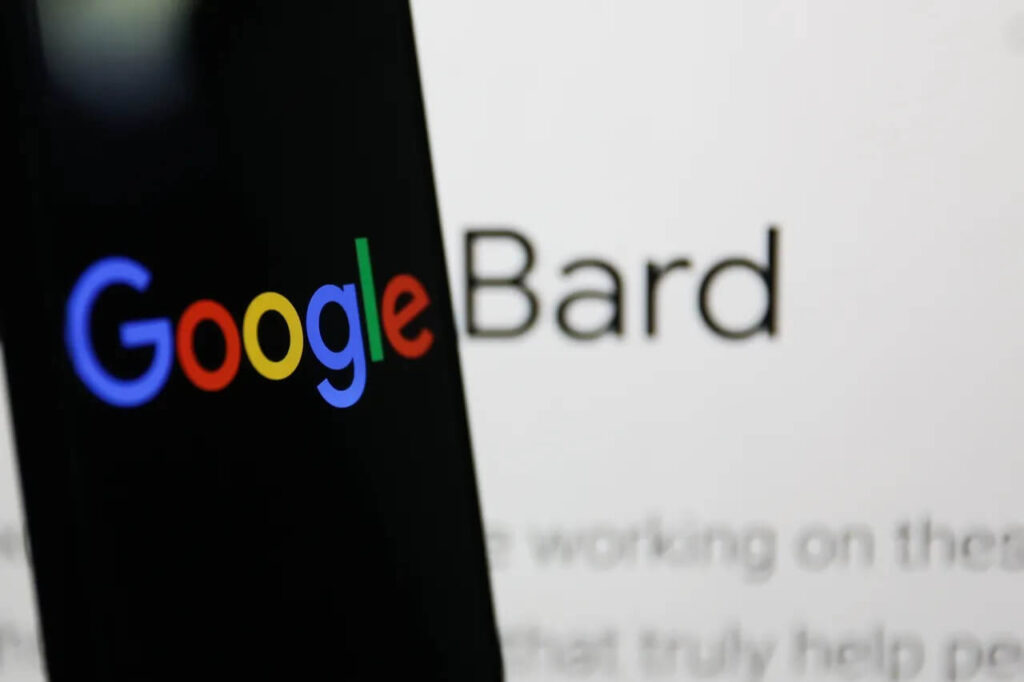
10 ways Google Bard AI is better than Chat GPT
#1. Use the Microphone To Enter Prompts
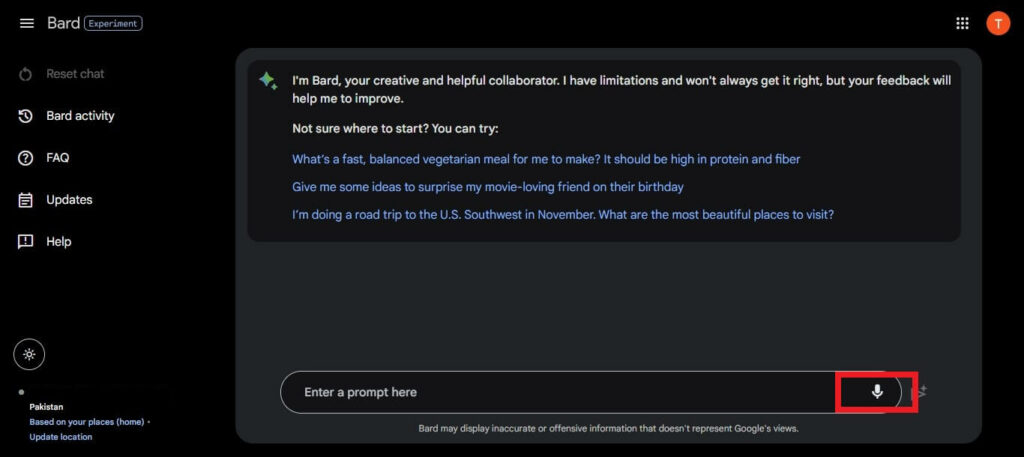
Bard offers the convenience of voice interaction, which proves to be advantageous in certain scenarios. Whether you’re on the move, occupied with tasks that keep your hands busy, or simply prefer speaking over typing, voice input provides a seamless means of interacting with Bard. Furthermore, voice input proves particularly useful when you need to dictate lengthy texts or pose intricate queries, enabling a more natural and effortless conversational experience. Embracing voice interaction with Bard opens up a range of possibilities, enhancing accessibility and efficiency for users in various situations.
Also Read- ChatGPT, Google Bard, Microsoft Bing- How They Are Similar But Yet Different
#2. ‘View Other Drafts’ Feature
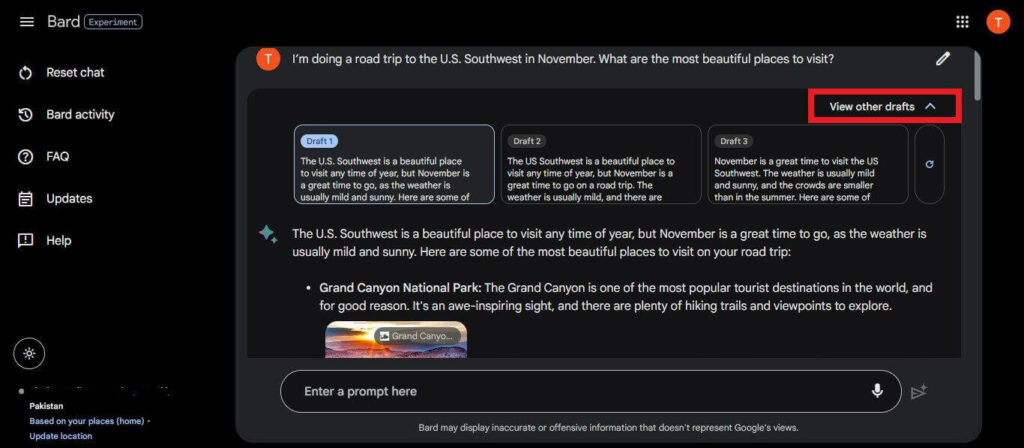
Google Bard has introduced a significant expansion in draft variety. When browsing through different drafts, users will now encounter a broader selection of options that possess greater distinctiveness from one another. This enhancement offers a wider range of unique drafts, fostering an environment conducive to exploring and expanding creative endeavors.
Also Read- Everything You Want To Know About Google Bard
#3. Export Conversation To Docs OR Gmail
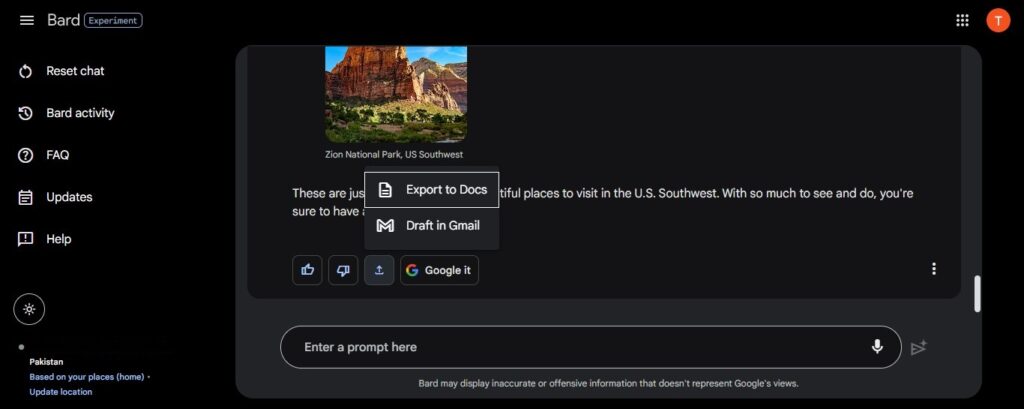
The inclusion of sharing functionality in Google Bard offers users an efficient means of sharing results with friends and colleagues. Beneath each response, users will find like, dislike, and export buttons. The export button provides two useful options: Export to Docs and Drafts in Gmail. These export functions streamline the process of composing emails, eliminating unnecessary hassle. While ChatGPT offers extensions for similar features, Google Bard comes equipped with export functionality by default, ensuring seamless sharing and enhanced productivity for its users.
Also Read- How Can I Access Bard AI On Google?
#4. Visual Responses
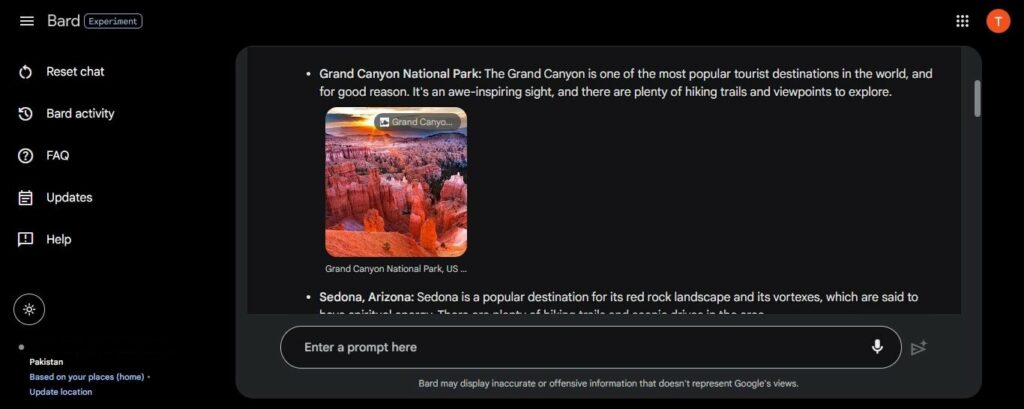
Although ChatGPT excels in generating comprehensive text responses, it falls short in the realm of image delivery. OpenAI has other properties, such as Dall-E, that specialize in generating images, which may explain this limitation.
However, Google Bard takes a different approach by incorporating images into its text responses. When posed with a question that can be answered with an image, Bard AI strives to find a relevant image and seamlessly integrates it into its response. For instance, if you ask Bard AI about the capital of France, it not only provides the answer “Paris” but also includes an image of the iconic Eiffel Tower, a renowned landmark in the city. This image-enhanced feature adds visual context and enriches the overall user experience when interacting with Google Bard.
#5. Suggest Relevant Google Searches
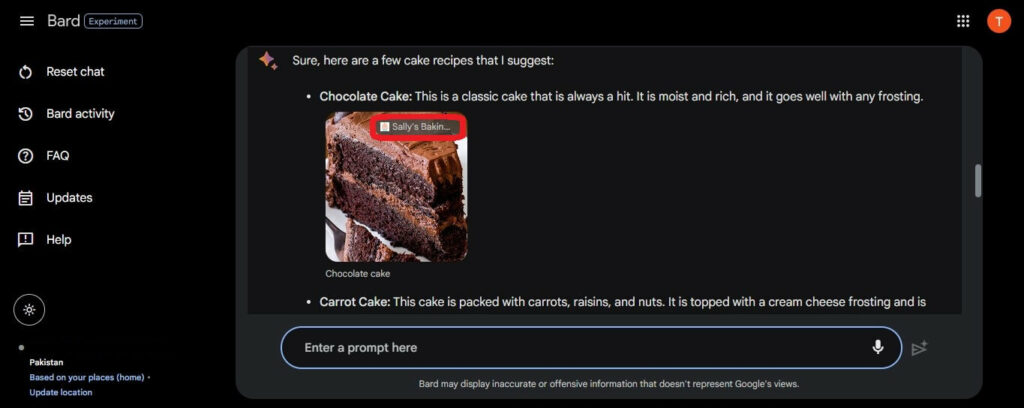
Google Bard offers a useful feature that goes beyond its own responses by suggesting relevant Google searches. This functionality serves as a valuable tool for discovering additional information on a given topic. By appending the word “suggest” to your query or prompt, Bard will generate a curated list of related Google searches. This authorizes you to dig deeper into the subject matter by tapping on any of the recommended searches and researching them further.
For instance, if you want to bake a cake and need a good recipe for it, you can ask Bard AI, to ‘suggest cake recipes’, it will give you various websites that have the best cake recipes so you can individually explore them.
#6. Empowered by Internet Access
Unlike ChatGPT, which lacks access to the internet by default, Google Bard comes equipped with internet access, giving it a distinct advantage over its OpenAI. Bard’s training encompasses a vast dataset comprising text and code, including information sourced from the internet.
As a result, Bard possesses the ability to provide comprehensive and insightful responses to inquiries. It can offer up-to-date news highlights and retrieve information directly from the web, enriching the user experience and enhancing the chatbot’s knowledge base. With internet access as a built-in feature, Google Bard offers a broader scope of information and a more dynamic range of capabilities.
#7. Bard Is Good With Coding
Ever since the introduction of Bard, Google received numerous user requests for coding-related features. Recognizing the demand, Google has expanded Bard’s capabilities to provide assistance in programming and software development tasks. Whether it’s code generation, debugging, or code explanation, Bard is equipped to support these needs. Besides that, Bard presents these functionalities in over 20 programming languages. This includes widespread ones, for instance, C++, Go, and Java as well as JavaScript, Python, and TypeScript.
To enhance your coding experience, we have also made it convenient to export Python code directly to Google Colab, eliminating the need for tedious copy-and-paste operations. Besides that, Bard has furthermore extended its support to writing functions for Google Sheets, additionally streamlining your workflow and productivity.
#8. Information Gap
A notable distinction between the two chatbots is the utilization of different underlying technologies. Bard’s LaMDA is capable of retrieving responses from the internet, ensuring that it remains up to date with the latest information. Moreover, being integrated into Google’s search engine, Bard can offer direct links to relevant websites when prompted.
In contrast, ChatGPT operates on the Generative Pre-training Transformer-4 (GPT-4) model, relying solely on its existing knowledge base. However, it is important to note that this knowledge base has a cutoff date of September 2021. Consequently, ChatGPT has limitations in accessing newer information and research, and it is unable to provide related links to external sources.
#9. Bard Integration Into Apps
Google has integrated Bard AI into its various apps and services, including Docs, Drive, Gmail, Maps, and more, into the AI chatbot experience. This integration aims to enhance the functionality and user experience of Google Bard. Additionally, Google introduced extensions, similar to Bing Chat, which will enable third-party services to seamlessly integrate with Bard, expanding its range of capabilities.
One notable partnership in the works is with Adobe Firefly, authorizing users to create and manipulate high-quality images that can be further edited utilizing Adobe Express. This collaboration strives to provide users with enhanced visual content creation and editing capabilities within the Bard platform.
Furthermore, Google is actively collaborating with a diverse spectrum of partners, including Kayak, OpenTable, ZipRecruiter, Instacart, Wolfram, and Khan Academy, among others. These partnerships are aimed at bringing additional functionality and services to Google Bard, providing users with a comprehensive and enriched chatbot experience.
#10. Get Organized With Bard
Bard offers valuable organizational features that can assist you in staying on top of your tasks, lessening stress, and expanding productivity. With Bard, you can furthermore effortlessly create to-do lists, set reminders, and effectively manage your calendar.
To utilize these organizational capabilities, all you need to do is input your request by typing or speaking, and then press Enter. Bard will promptly generate a comprehensive to-do list, set reminders for important events or deadlines, and efficiently handle your calendar management tasks. By leveraging Bard’s organizational tools, you can streamline your workflow and assure that you remain on track with your commitments.
Frequently Asked Questions
Is Google Bard better than ChatGPT?
Determining whether Google Bard is better than ChatGPT or vice versa depends on the specific requirements and preferences of the user. Both chatbots have their unique strengths and features that cater to different requirements.
Google Bard, powered by technologies like PaLM 2 and LaMDA, offers capabilities such as generating code explanations, providing images in responses, suggesting related Google searches, integrating with various Google services, and more. It excels in areas like code understanding and integration with the Google ecosystem.
On the other hand, ChatGPT, based on the GPT-3.5 architecture, has demonstrated proficiency in generating comprehensive text responses, handling natural language queries, and providing general conversational capabilities. Ultimately, the choice between Google Bard and ChatGPT depends on the specific use case, desired functionalities, and personal preferences of the user.
Who is the competitor of ChatGPT?
There are several notable contenders in the field of AI-Language Models (LLMs), including:
- Google Bard (LaMDA)
- Microsoft Bing AI
- DeepMind Sparrow
- Amazon’s new language model


























![The Apex Legends Digital Issue Is Now Live! Apex Legends - Change Audio Language Without Changing Text [Guide]](https://www.hawkdive.com/media/5-Basic-Tips-To-Get-Better-On-Apex-Legends-1-218x150.jpg)



